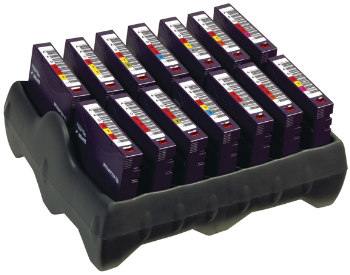
Editorial: By Andrew Dodd, WW Marketing Communications Manager, HP Storage Media
As video cameras become smaller and more robust, they are starting to show up almost everywhere in daily life: for leisure, business and emergency service use. The footage captured by ?dash cams? during police activities has proven to be a valuable asset, so much so that many police officers are starting to wear body cams for the same reasons.
All these cameras create a substantial amount of data that forces the need to manage, maintain, and protect as this data maybe recalled as evidence. It needs to be ?tamper proof? to protect the integrity of the content. With the new tape-as-NAS solution combined with LTO WORM, we now have a solution that can provide economical storage and integrity protection.
From a storage standpoint, the deployment of body cameras inevitably means a new source of data – and depending on the nature of the devices used (HD, 1080p, etc.) – very large amounts of it. In January of this year, the U.S. Department of Homeland Security (DHS), as part of its program called System Assessment and Validation for Emergency Responders (SAVER),conducted an “operationally-oriented assessment of body worn cameras.?
The cameras in the SAVER review* ranged from 8 GB to 32 GB and could store anything from a Body Camera.jpgmaximum of 4-to-35 hours of HD footage. 32 GB is not a lot in itself, but consider that the New York police department has about 34,000 uniformed officers. If body cameras were standard issue across every NYPD law enforcement department and each officer captured just one hour of HD footage every day, the storage requirement would be colossal.
Without getting into compression codecs and formats, if we assume five minutes of HD 1080i footage is about 1 GB, then a single hour of filming throughout a shift might generate 15 GB of data. And that would soon multiply.
For example:
34,000 officers
1 hour or 15 GB footage per day
5 days per week = 60 GB per officer
2.04 PB of data for the entire NYPD in a single working week
So how do you store so much sensitive data?
Video surveillance asset management (vSAM) has already gained recognition as a major storage opportunity and a number of tape-based appliances have been introduced that incorporate vSAM. Instead of simply overwriting the previous day?s, week?s or month?s captured video assets on primary storage or storing massive amounts of mostly low-value data, these vSAM appliances relocate video data in its entirety to an LTO tape.
But owing to the fundamental importance of respecting legal processes and civil liberties, body camera data should ideally be stored to a higher standard of integrity and security than ?ordinary? vSAM material. The DHS SAVER report did not address storage for body worn cameras at all, but concerns have been raised about police departments using cloud services, due to concerns about hidden and excessive costs, access, control and cyber security.
That’s why tamper-proof WORM LTO tape could be the perfect partner for this emerging trend in transparency and oversight in law enforcement and other areas of public life. HP LTO-3, 4, 5 and 6 tape drives feature the ability to archive and store data in a non-rewriteable, WORM format that meets the most stringent regulatory guidelines.
Using a combination of integrated fail-safe features in the drive firmware, cartridge memory and tape formatting, LTO Ultrium drives can archive large amounts of data for periods of up to 30 years in a secure, tamper-proof state. Whatever footage gets saved onto a WORM tape remains exactly as it was filmed.
And once that tape is moved offline and offsite into a secure vault, it is to all intents and purposes beyond malicious intent. And for the highest level of security, WORM deployed with native, hardware based AES-256 encryption, can provide maximum confidentiality for data at rest.
A storage array connected to a SAN can theoretically be hacked or corrupted if the hacker possesses sufficient time, skill and resources. But the only way to hack or corrupt a tape in a vault is to physically steal it or destroy the vault. In a court of law, where beyond all reasonable doubt is the guiding principle, LTO WORM tape is true ?beyond-all-reasonable-doubt? storage.
More advantages that come with LTO WORM tape
Yet for hard pressed IT managers and purchasers (and because WORM is ultimately tape technology like any other), archives can be expanded simply by buying extra tapes from a vast network of supplies resellers. WORM tape users enjoy all the same competition and innovation benefits of the open LTO Ultrium format.
Once the footage is recorded, it?s a simple process to transfer the video from the original source and onto tape. A tape-as-NAS** solution that uses WORM would be ideal for receiving body camera data, where it could be held in a secure disk cache (e.g. for the completion of short term procedural activity relating to investigations) before being transferred to a long term, automated tape archive using LTO Ultrium WORM. And once on the WORM tape, CIOs, law officers and legal professionals can be completely confident that the data is secure and protected from any accidental alteration.
It seems likely that body cameras will be deployed more widely in the years ahead, which means that the topic of how best to store manage and store the petabytes of data they create will be a fresh challenge for IT managers. But with LTO Ultrium WORM tape and tape-as-NAS, there?s already a solution that is ideally suited to help you meet that challenge.
*http://www.firstresponder.gov/SAVER/Documents/Body-Worn-Cams-AR_0415-508.pdf
http://h30507.www3.hp.com/t5/Around-the-Storage-Block-Blog/What-is-Tape-as-NAS-or-tNAS/ba-p/182718
Source: www3.hp.com
